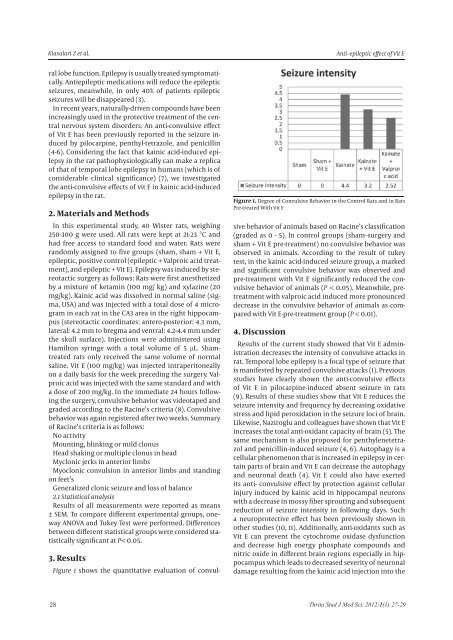by Author Index by Keywords - Index of
by Author Index by Keywords - Index of
by Author Index by Keywords - Index of
Create successful ePaper yourself
Turn your PDF publications into a flip-book with our unique Google optimized e-Paper software.
Kiasalari Z et al.<br />
ral lobe function. Epilepsy is usually treated symptomatically.<br />
Antiepileptic medications will reduce the epileptic<br />
seizures, meanwhile, in only 40% <strong>of</strong> patients epileptic<br />
seizures will be disappeared (3).<br />
In recent years, naturally-driven compounds have been<br />
increasingly used in the protective treatment <strong>of</strong> the central<br />
nervous system disorders. An anti-convulsive effect<br />
<strong>of</strong> Vit E has been previously reported in the seizure induced<br />
<strong>by</strong> pilocarpine, penthyl-tetrazole, and penicillin<br />
(4-6). Considering the fact that kainic acid-induced epilepsy<br />
in the rat pathophysiologically can make a replica<br />
<strong>of</strong> that <strong>of</strong> temporal lobe epilepsy in humans (which is <strong>of</strong><br />
considerable clinical significance) (7), we investigated<br />
the anti-convulsive effects <strong>of</strong> vit E in kainic acid-induced<br />
epilepsy in the rat.<br />
2. Materials and Methods<br />
In this experimental study, 40 Wister rats, weighing<br />
250-300 g were used. All rats were kept at 21-23 °C and<br />
had free access to standard food and water. Rats were<br />
randomly assigned to five groups (sham, sham + Vit E,<br />
epileptic, positive control (epileptic + Valproic acid treatment),<br />
and epileptic + Vit E). Epilepsy was induced <strong>by</strong> stereotactic<br />
surgery as follows: Rats were first anesthetized<br />
<strong>by</strong> a mixture <strong>of</strong> ketamin (100 mg/ kg) and xylazine (20<br />
mg/kg). Kainic acid was dissolved in normal saline (sigma,<br />
USA) and was injected with a total dose <strong>of</strong> 4 microgram<br />
in each rat in the CA3 area in the right hippocampus<br />
(stereotactic coordinates: antero-posterior: 4.3 mm,<br />
lateral: 4.2 mm to bregma and ventral: 4.2-4.4 mm under<br />
the skull surface). Injections were administered using<br />
Hamilton syringe with a total volume <strong>of</strong> 5 µL. Shamtreated<br />
rats only received the same volume <strong>of</strong> normal<br />
saline. Vit E (100 mg/kg) was injected intraperitoneally<br />
on a daily basis for the week preceding the surgery. Valproic<br />
acid was injected with the same standard and with<br />
a dose <strong>of</strong> 200 mg/kg. In the immediate 24 hours following<br />
the surgery, convulsive behavior was videotaped and<br />
graded according to the Racine’s criteria (8). Convulsive<br />
behavior was again registered after two weeks. Summary<br />
<strong>of</strong> Racine’s criteria is as follows:<br />
No activity<br />
Mounting, blinking or mild clonus<br />
Head shaking or multiple clonus in head<br />
Myclonic jerks in anterior limbs<br />
Myoclonic convulsion in anterior limbs and standing<br />
on feet’s<br />
Generalized clonic seizure and loss <strong>of</strong> balance<br />
2.1 Statistical analysis<br />
Results <strong>of</strong> all measurements were reported as means<br />
± SEM. To compare different experimental groups, one–<br />
way ANOVA and Tukey Test were performed. Differences<br />
between different statistical groups were considered statistically<br />
significant at P< 0.05.<br />
3. Results<br />
Figure 1 shows the quantitative evaluation <strong>of</strong> convul-<br />
Anti–epileptic effect <strong>of</strong> Vit E<br />
Figure 1. Degree <strong>of</strong> Convulsive Behavior in the Control Rats and in Rats<br />
Pre-treated With Vit E<br />
sive behavior <strong>of</strong> animals based on Racine’s classification<br />
(graded as 0 - 5). In control groups (sham–surgery and<br />
sham + Vit E pre-treatment) no convulsive behavior was<br />
observed in animals. According to the result <strong>of</strong> tukey<br />
test, in the kainic acid-induced seizure group, a marked<br />
and significant convulsive behavior was observed and<br />
pre-treatment with Vit E significantly reduced the convulsive<br />
behavior <strong>of</strong> animals (P < 0.05). Meanwhile, pretreatment<br />
with valproic acid induced more pronounced<br />
decrease in the convulsive behavior <strong>of</strong> animals as compared<br />
with Vit E-pre-treatment group (P < 0.01).<br />
4. Discussion<br />
Results <strong>of</strong> the current study showed that Vit E administration<br />
decreases the intensity <strong>of</strong> convulsive attacks in<br />
rat. Temporal lobe epilepsy is a focal type <strong>of</strong> seizure that<br />
is manifested <strong>by</strong> repeated convulsive attacks (1). Previous<br />
studies have clearly shown the anti-convulsive effects<br />
<strong>of</strong> Vit E in pilocarpine-induced absent seizure in rats<br />
(9). Results <strong>of</strong> these studies show that Vit E reduces the<br />
seizure intensity and frequency <strong>by</strong> decreasing oxidative<br />
stress and lipid peroxidation in the seizure loci <strong>of</strong> brain.<br />
Likewise, Naziroglu and colleagues have shown that Vit E<br />
increases the total anti-oxidant capacity <strong>of</strong> brain (5). The<br />
same mechanism is also proposed for penthylenetetrazol<br />
and penicillin-induced seizure (4, 6). Autophagy is a<br />
cellular phenomenon that is increased in epilepsy in certain<br />
parts <strong>of</strong> brain and Vit E can decrease the autophagy<br />
and neuronal death (4). Vit E could also have exerted<br />
its anti- convulsive effect <strong>by</strong> protection against cellular<br />
injury induced <strong>by</strong> kainic acid in hippocampal neurons<br />
with a decrease in mossy fiber sprouting and subsequent<br />
reduction <strong>of</strong> seizure intensity in following days. Such<br />
a neuroprotective effect has been previously shown in<br />
other studies (10, 11). Additionally, anti-oxidants such as<br />
Vit E can prevent the cytochrome oxidase dysfunction<br />
and decrease high energy phosphate compounds and<br />
nitric oxide in different brain regions especially in hippocampus<br />
which leads to decreased severity <strong>of</strong> neuronal<br />
damage resulting from the kainic acid injection into the<br />
28 Thrita Stud J Med Sci. 2012;1(1):27-29


